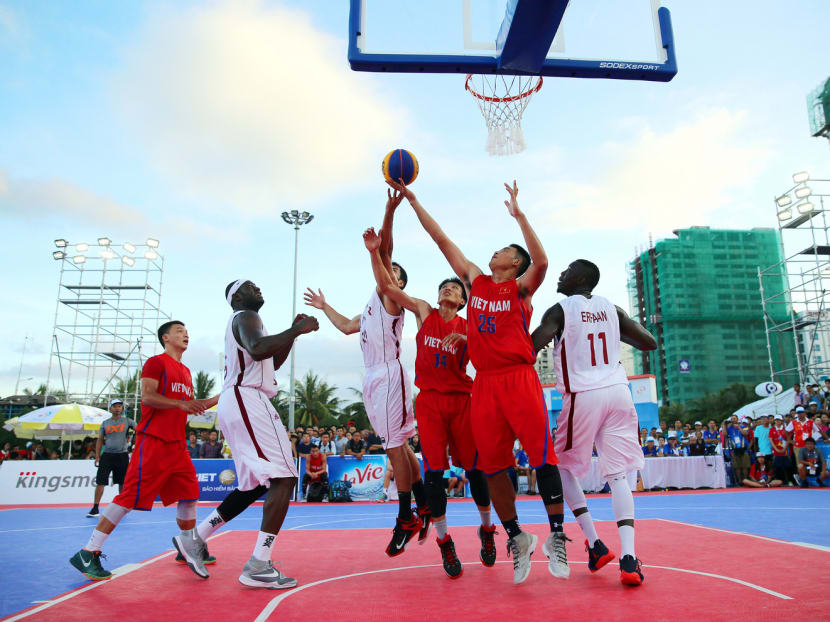3-on-3 basketball has 2020 vision for Tokyo
DANANG (VIETNAM) — Asia’s growing fascination with three-on-three basketball, the game’s half-court version that is already hugely popular in streets and backyards the world over, has given the International Basketball Federation (Fiba) fresh hope that it can get the sport into the Tokyo 2020 Olympics.

A 3-on-3 basketball match between Qatar (white) and Vietnam (red) at the Asian Beach Games in Danang. Asia has been the driving force behind the inclusion of the high-speed game in major sports events. Photo: AFP
DANANG (VIETNAM) — Asia’s growing fascination with three-on-three basketball, the game’s half-court version that is already hugely popular in streets and backyards the world over, has given the International Basketball Federation (Fiba) fresh hope that it can get the sport into the Tokyo 2020 Olympics.
Fiba’s previous attempts to win Olympic status for the abbreviated format have failed, but the governing body is more optimistic than ever because of the International Olympic Committee’s (IOC) stated desire to include more sports that appeal to younger generations.
Although three-on-three basketball fits that criteria and has its own roots in urban America, Asia has been the driving force behind the inclusion of the high-speed game in major multi-sports events.
The sport has been featured at the Asian Beach Games, Asian Indoor Games and Asian Youth Games and will be on show at the next Asian Games in 2018. It was also included at last year’s inaugural European Games in Azerbaijan and, significantly, was played at the first two Youth Olympics, both held in Asia.
The IOC has introduced new rules giving Olympic hosts more power and flexibility in choosing their own sports and disciplines, and a decision on the final programme for Tokyo is expected next June with three-on-three hoops among the list of candidates.
“There’s a lot of discussions going on,” Nicolas Widmer, a three-on-three development assistant for Fiba, said. “It won’t replace five-on-five, it would be an addition. It’s a new discipline so it doesn’t mean adding a new sport, and that’s how we are bidding.”
Widmer was among a Fiba delegation that travelled to central Vietnam to monitor the three-on-three tournament at the Asian Beach Games. Played outdoors in a temporary venue next to Danang’s main tourist beach, Widmar said the tournament was a great advertisement for the sport’s popularity and increasing diversity, with the stands packed at every session.
Qatar won the men’s gold medal, beating Mongolia in the final, while Iraq won the bronze in thrilling fashion, with their Texan-based centre Abdullah Hassan Ali draining a buzzer-beater from outside the arc to seal his team’s one-point win.
China, which has already started a national programme to develop specialist three-on-three players, won the women’s gold, beating Thailand in the final, while Taiwan collected the bronze.
“It’s a new opportunity for new countries, and we’ve seen some really good examples at the Asian Beach Games,” Widmer said.
“The level of the competition was surprisingly high and we can see that teams prepared and practised specifically for this type of basketball. They didn’t just bring players that know basketball, they brought players that train specifically to play three-on-three.
“It’s a universal discipline played in a lot of different countries, and it’s a sport where smaller countries can perform because you don’t need a lot of infrastructure, and it’s a cheap event that can be played anywhere.”
Widmer said it was too early to speculate on whether NBA players would play three-on-three at the Olympics if it was included. He said Fiba’s expectation was that most countries would follow the lead of sevens rugby and beach volleyball by developing separate squads, although he expected a lot of established five-on-five stars would be tempted to try the shortened format.
“We have good examples where teams and players that are totally focused on three-on-three beat players that are better known and very good at five-on-five,” Widmer said.
“We expect most NOCs (National Olympic Committees) will develop specialist players but I’m sure there will be some very good five-on-five players who will want to do it because it’s a new opportunity for them as well.” AFP





